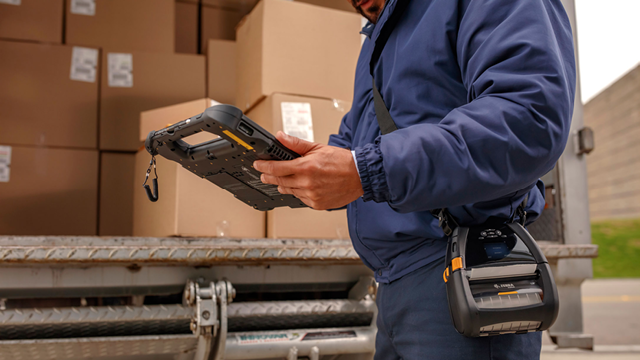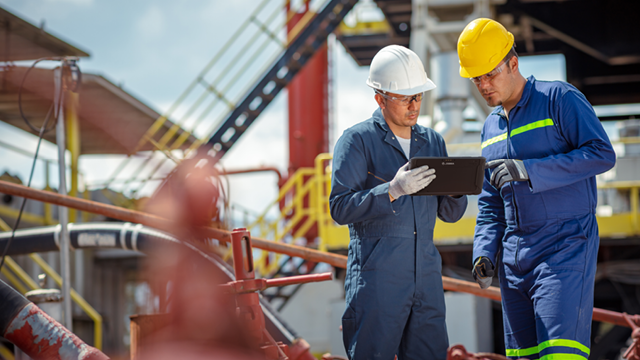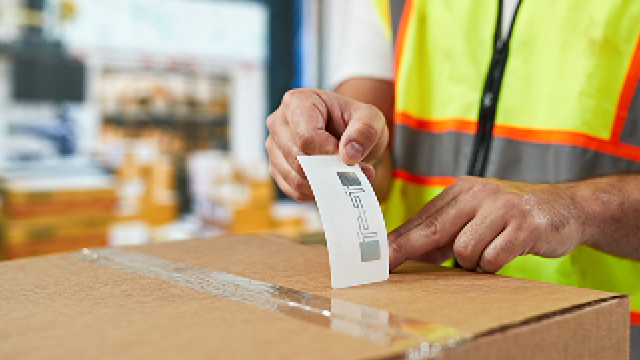When Rapid Reponse and Reliable Access to Information is Mission-Critical
Making the case for rugged mobile tablet solutions for police, firefighters, and EMS workers.
BlueStar's diverse portfolio offers unparalleled access to premium products and services that drive business growth and success. From state-of-the-art hardware to advanced software solutions, our portfolio is designed to empower businesses with the tools they need to thrive in today's competitive landscape.
Our vertical-based content focuses on different industry technologies, solutions, and insights.
A true VAD offers top-notch pick, pack and ship services, and provides programs and services that add value to the distributed products that increase their value or worth.
The BlueStar Difference8 min read
BlueStar March 28, 2025 9:08:55 AM EDT

Why competitive T&L and warehouse operations are deploying rugged mobile tablet solutions.
Transportation and logistics (T&L) and warehouse operations are upgrading technology, leaving behind legacy on-premises management systems and paper-based processes in favor of cloud solutions and mobility. In many cases, the transition has been planned for a while, part of an IT roadmap designed to take operations to greater efficiency and productivity. However, recent challenges have created a sense of urgency to equip their employees with rugged tablets and complementary solutions to gain greater visibility, agility, and competitiveness.
T&L and warehouse challenges
The challenges that T&L and warehouse operations face are significant—and their impact is compounded because they coincide. T&L companies and warehouses are adapting to global supply chain disruptions due to the COVID-19 pandemic, unrest in Eastern Europe, and other factors around the world. Companies are also looking for ways to maintain productivity during a labor shortage and changes to their workforces. While finding ways to address these issues, companies are also confronted with increasing customer demands to move shipments more quickly.
Furthermore, as companies adapt processes and create new strategies to manage operations in the 2020s, T&L and warehouse operations face increasing costs. An Inbound Logistics survey of T&L technology providers revealed that 85% of companies consider cost reduction their most critical challenge.1
Rugged tablets can help operations ease pressures created by these challenges by keeping employees connected to the company’s enterprise resource planning (ERP) or management system. Employees who can collect data at the point of task work more efficiently, saving time and reducing the need for additional labor or overtime. Real-time data also helps meet customers’ demands for visibility into their shipments and increases customer satisfaction.
However, mobile devices must be designed for T&L and warehouse use cases and able to withstand use in harsh industrial environments and exposure to extreme weather conditions as workers move in and out of buildings and vehicles. T&L companies also need rugged tablets and vehicle-mounted solutions that give their teams access to communications, applications, and data while keeping their hands free to perform their jobs productively and safely.7
Mobile Solutions: Step One to Automate Operations
Automation is key to greater efficiency, productivity, and cost savings. A Zebra™ 2019 Warehousing Vision Study reveals that 77% of T&L and warehouse decision makers believe a connected workforce is the best way to introduce automation.2 The study also found that 80% of organizations plan to invest in new technologies to increase competitiveness. Those plans include upgrading or extending their management systems to enhance mobile user experiences and begin modernization by equipping workers with mobile devices. In addition, a growing number of organizations plan to use mobile execution systems to manage mobile workers. Finally, about one-third of organizations plan to use augmented reality (AR) or virtual reality (VR) to guide employees through workflows within five years.
Organizations’ objectives for deploying mobile devices include increasing employee efficiency, enhancing the ability to adapt to complex workflows, and stabilizing performance during employee turnover or onboarding seasonal workers.
1. Rugged. Period.
Some T&L companies have taken a casual attitude toward using consumer-grade tablets, assuming that if a device breaks, it’s inexpensive to replace. However, costs aren’t only related to the device itself. For example, a broken screen or device failure creates a loss of productivity and requires resources to replace, provision and configure a new tablet. Moreover, this cycle could frequently recur depending on operational conditions, eliminating any perceived cost savings from using consumer tablets.
Furthermore, purpose-built rugged tablets are designed for performance in harsh environments. They’re designed and tested to meet MIL-STD or IP ratings, sealed to prevent damage from dust ingress and splashing or spraying water and able to withstand drops or shock from extreme temperature changes. Rugged tablet design also considers how T&L employees work, for example, with daylight-readable screens and touchscreen technology that works when employees wear gloves. In addition, some rugged tablets give users the option of a touchscreen or keyboard to facilitate data entry.
2. Operating system
Now that Microsoft has ended Windows Mobile and CE support, many T&L and warehouse operations are transitioning to Android. For example, the Zebra™ 2019 Warehousing Vision Study revealed that 83% currently use or plan to use Android by 2024 to provide their employees with a modern touch interface.3 Objectives for the transition to Android in the warehouse and T&L operations include increasing worker efficiency and adopting the system’s familiar and easy-to-use interface that allows consistent performance through workforce changes and training.
3. People-proof security policies
Newly deployed mobile devices can introduce vulnerabilities to hacking, phishing, and cyberattacks. Given the option, employees may not choose to use strong passwords or enable multifactor authentication (MFA), which they may feel “slows them down.” Instead, rugged tablets for T&L and warehouse operations should enable biometric authentication via fingerprint or facial scan or using common access cards (CACs) and PINs to verify a user’s identity, allowing users to log in quickly while preventing a hacker from gaining access to the device.
4. Mobile device management
Although device selection, provisioning, configuration, and implementation are vital steps in creating a connected, mobile workforce, it’s essential to look beyond those phases of the project to consider mobile device management (MDM). Devices will need updates, patches, and maintenance throughout their lifetime. Additionally, monitoring devices allows IT administrators to act proactively, replacing devices before they fail and cause downtime.
Fortunately, companies can choose from a range of solutions to manage rugged tablets, including Zebra’s suite of solutions for managing Android devices. VisibilityIQ™ provides mobile fleet intelligence when and how you need it, so you can run smoother operations. Varying levels of support help you choose what’s best for your business. VisibilityIQ Foresight™ aggregates your big data onto a single, color-coded, cloud-based pane of glass and translates it into actionable insight to streamline workflow. Zebra OneCare™ offers a cloud-based dashboard that provides status views of your device repair and support information, contracts, case lifecycle, and LifeGuard analytics reports.
5. Connectivity
T&L and warehouse operations need to overcome connectivity challenges, whether drivers are traveling to areas with unreliable network service or workers in the warehouse experience intermittent connectivity due to the types of material stored on the shelves. Rugged tablets suited to these use cases will have connectivity options, including Bluetooth, 4G or 5G, and Wi-Fi 6E, that ensure employees can always send and receive communications and data as they work.
6. Peripherals and complementary solutions
Keeping employees connected to the company’s management system is only part of the solution. It’s also necessary to equip them with all the tools to do their jobs effectively. For example, employees who need to print labels will save time with mobile printers. In addition, some workers will benefit from having multiple devices on a warehouse cart or workstation that organizes and powers the tools they need. Also, accessories such as ergonomic hand or shoulder straps make tablets easier to carry and use.
7. Options for mounting on Forklifts/Vehicles
Specific use cases might also suggest replacing some forklift vehicular computers with dedicated forklift tablets. Such decisions can be typically motivated by taking advantage of the higher flexibility offered by tablets for use outside of the forklift vehicle across further applications and use cases. They can also be driven by the need of taking advantage of the latest 4G/5G connectivity options offered by the tablets, as they have been mentioned in one of the previous paragraphs. Last, forklift with tablets installed on-board may also benefit from external antennas mounted on vehicle roofs and from pass-through antenna docking modules, enabling a better and more reliable receiving of the WiFi, 4G and 5G radio signals throughout the logistic facilities.
6 Ways Mobile Technologies Support T&L and Warehouse Operations
Consider the impact rugged tablets make on performance, efficiency, and accuracy in every T&L or warehouse operation area.
Optimizing Resources and Meeting Customer Demands
Green Logistics Groningen transitions to a user-friendly, scalable solution that increases efficiency and lowers costs.
Green Logistics Groningen, based in Aduard in the Netherlands, distributes products across Europe, primarily from large American manufacturers. Faced with changing consumer shopping behaviors, demands for increased visibility into orders, and a growing range of products by implementing new technology, Green Logistics decided to upgrade its management system and the devices that its team uses to access it.
Green Logistics began searching for an order fulfillment system with adaptability, scalability, and reliability. The company also required a user-friendly system that makes training easy for new employees and temporary, seasonal staff.
Rugged Tablets and Mobile Management Solutions from One Provider
Green Logistics Groningen chose a system comprised of software from ScanSolutions and mobile devices and device management from Zebra Technologies™.4
Zebra™ ET50 tablets are now central to running final checks on orders, including whether packages need additional labels because they contain hazardous substances or fragile goods. Employees use Zebra™ devices for a final scan and then put boxes on the correct pallets for shipment. The data collected at this phase and throughout the process of preparing the order are shared with customers via Green Logistics’ customer portal, providing real-time visibility.
Green Logistics also leverages solutions from Zebra’s Android toolkit, including Zebra™ Mobility DNA, making device management and troubleshooting easier. It also leverages Zebra™ StageNow for device staging and Zebra™ Enterprise Home Screen to define and control which applications can run on each device.
Danny Berg, Green Logistics warehouse manager, says, “Having Zebra™ as our sole hardware supplier and the bespoke, scalable Arox WMS software from ScanSolutions guarantees continuity for us. In addition, we can now control every aspect of the logistics process, from pallet delivery to the customer’s door. That allows us to be truly customer-focused.”
Increased Productivity and Efficiency and Time Savings
Green Logistics’ new mobile solutions and WMS delivered all of the features and capabilities the company required, including visibility into operations and intuitive user interfaces that make training quick and easy. The solution also enables fast scaling and order accuracy during peak seasons. As a result, the company has reduced costs through greater automation, reducing the number of employees needed in goods receipt, returns, and order processing and deploying them to other areas of the business.
Additionally, Green Logistics is better positioned to serve its high-end customers. Arno Bruining, Green Logistics CEO, says, “Zebra™ is a high-end brand in its sector too, so it sits very comfortably with Green Logistics. Its products are perfectly suited and designed with the warehouse environment in mind. And such an extensive high-performance, easy-to-use, reliable Android portfolio makes Zebra™ the obvious hardware partner for future-proof warehouse solutions.”
The Benefits of One Rugged Device Vendor That Meets All of Your Needs
Rugged tablets are the go-to tool for many T&L and warehouse use cases. Vehicle-mounted tablets enable communications while maintaining driver safety. The larger tablet screen optimally displays the user interface for many warehouse applications, and native features, such as wireless connectivity, camera, barcode scanner, and biometric authentication via fingerprint or facial scan, keep devices secure.
However, creating a modern, connected operation may require more options. The key with mobile solutions that help achieve business goals is to choose a form factor that supports how the employee works—not requiring the employee to change their workflows to use the device. Therefore, in addition to rugged tablets that employees carry or mount on a vehicle, team members may benefit from wearable computers and headsets or smart glasses or headsets that enable, for example, directed picking. Additionally, some employees may benefit from handheld mobile computers or handheld or ring scanners. T&L and warehouse operations also benefit from industrial and portable printers to print order or pick lists and shipping and customer labels.
Choosing rugged devices from different vendors for a T&L or warehouse operation can create extra work to source devices, troubleshoot when issues arise, order consumables—and control costs. The best strategy is to choose one hardware vendor with a comprehensive portfolio of rugged devices designed to be a part of an integrated IT ecosystem and deliver optimal performance in warehouse environments and on the road in transportation and logistics operations.
Carefully weigh your options and make informed purchasing decisions about rugged tablets and the other devices, accessories, and complementary solutions that will provide your operation with the greatest value. It is the first step in achieving the efficiency, agility, visibility, and competitiveness driving the transition to mobile solutions.
Learn More about How Zebra™ and BlueStar Help Create Modern T&L and Warehouse Operations
https://reach.bluestarinc.com/zebra-rugged-tablets-offer-at-bluestar

Making the case for rugged mobile tablet solutions for police, firefighters, and EMS workers.

Why rugged mobile tablet solutions are pivotal to field services and utility operations.

RFID solutions give T&L operations visibility, track-and-trace capabilities, efficiency, and accuracy that mitigate losses, control costs, and...